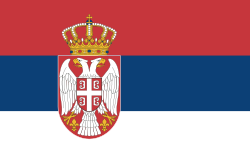PTT Thailand Open 2013 – mužská čtyřhra
| PTT Thailand Open 2013 | |
|---|---|
| Vítězové: | |
| Finalisté: | |
| Výsledek: | 6–3, 3–6, [10–6] |
| Soutěže | |
| mužská dvouhra • mužská čtyřhra | |
Do soutěže mužské čtyřhry na tenisovém turnaji PTT Thailand Open 2013 nastoupilo šestnáct dvojic. Obhájcem titulu byl tchajwansko-thajský pár Lu Jan-sun a Danai Udomčoke, který ve čtvrtfinále prohrál s Jamiem Murraym a Johnem Peersem.
Deblový titul vyhrála třetí nasazená britsko-australská dvojice Jamie Murray a John Peers, která ve finále zdolala polsko-švédské turnajové čtyřky Tomasze Bednarka s Johanem Brunströmem po rovnocenném zisku prvních dvou setů 6–3 a 3–6, až v rozhodujícím supertiebreaku [10–6].
Jamie Murray si připsal třetí deblový triumf sezóny a celkově desátý kariérní. Pro Johna Peerse výhra znamenala třetí turnajové vítězství na okruhu ATP Tour ve čtyřhře. Oba tak společně vybojovali třetí triumf.
Nasazení párů
 Mahesh Bhupathi /
Mahesh Bhupathi /  Robert Lindstedt (1. kolo)
Robert Lindstedt (1. kolo) Daniele Bracciali /
Daniele Bracciali /  Leander Paes (semifinále)
Leander Paes (semifinále) Jamie Murray /
Jamie Murray /  John Peers (vítězové)
John Peers (vítězové) Tomasz Bednarek /
Tomasz Bednarek /  Johan Brunström (finále)
Johan Brunström (finále)
Pavouk
| Legenda | ||
|
|
|
| První kolo | Čtvrtfinále | Semifinále | Finále | ||||||||||||||||||||||
| 1 | | 6 | 3 | [8] | |||||||||||||||||||||
| | 2 | 6 | [10] | | 4 | 4 | |||||||||||||||||||
| WC | | 4 | 3 | | 6 | 6 | |||||||||||||||||||
| | 6 | 6 | | 3 | 3 | ||||||||||||||||||||
| 4 | | 6 | 77 | 4 | | 6 | 6 | ||||||||||||||||||
| | 4 | 65 | 4 | | 7 | 6 | |||||||||||||||||||
| | 2 | 6 | [8] | | 5 | 3 | |||||||||||||||||||
| | 6 | 4 | [10] | 4 | | 3 | 6 | [6] | |||||||||||||||||
| | 63 | 7 | [1] | 3 | | 6 | 3 | [10] | |||||||||||||||||
| WC | | 77 | 5 | [10] | WC | | 67 | 5 | |||||||||||||||||
| | 66 | 4 | 3 | | 79 | 7 | |||||||||||||||||||
| 3 | | 78 | 6 | 3 | | 6 | 6 | ||||||||||||||||||
| | 7 | 7 | 2 | | 3 | 4 | |||||||||||||||||||
| | 5 | 5 | | 77 | 68 | [8] | |||||||||||||||||||
| | 5 | 64 | 2 | | 64 | 710 | [10] | ||||||||||||||||||
| 2 | | 7 | 77 | ||||||||||||||||||||||
Odkazy
Reference
V tomto článku byl použit překlad textu z článku 2013 PTT Thailand Open – Doubles na anglické Wikipedii.
Externí odkazy
Média použitá na této stránce
Flag of Australia, when congruence with this colour chart is required (i.e. when a "less bright" version is needed).
See Flag of Australia.svg for main file information.The national flag of Kingdom of Thailand; there are total of 3 colours:
- Red represents the blood spilt to protect Thailand’s independence and often more simply described as representing the nation.
- White represents the religion of Buddhism, the predominant religion of the nation
- Blue represents the monarchy of the nation, which is recognised as the centre of Thai hearts.
Vlajka České republiky. Podoba státní vlajky České republiky je definována zákonem České národní rady č. 3/1993 Sb., o státních symbolech České republiky, přijatým 17. prosince 1992 a který nabyl účinnosti 1. ledna 1993, kdy rozdělením České a Slovenské Federativní republiky vznikla samostatná Česká republika. Vlajka je popsána v § 4 takto: „Státní vlajka České republiky se skládá z horního pruhu bílého a dolního pruhu červeného, mezi něž je vsunut žerďový modrý klín do poloviny délky vlajky. Poměr šířky k její délce je 2 : 3.“
Chinese Taipei Olympic Flag. According to the official website of Chinese Taipei Olympic Committee, Blue Sky(circle) & White Sun(triangles) above the Olympic rings is neither the National Emblem of the Republic of China, nor the Party Emblem of Kuomintang (KMT), but a design in between, where the triangles do not extend to the edge of the blue circle, as registered at International Olympic Committee in 1981 and digitally rendered in 2013. Besides, the blue outline of the five-petaled plum blossom is broader than the red one. Moreover, the CMYK code of the blue one and the Blue Sky & White Sun is "C100-M100-Y0-K0", and different from the Olympic rings (C100-M25-Y0-K0). Note that it's the only version recognized by IOC.
Flag of Canada introduced in 1965, using Pantone colors. This design replaced the Canadian Red Ensign design.



















